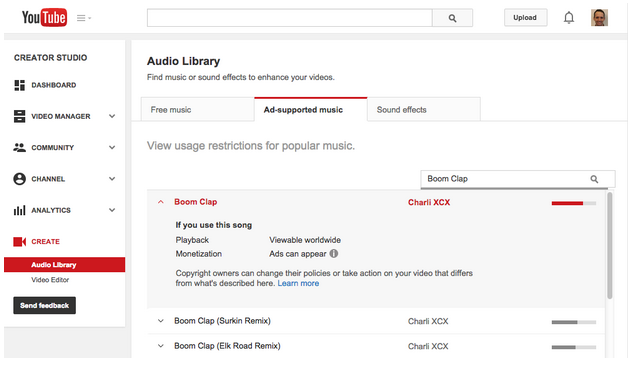
On Monday YouTube announced that it will list the copyright terms of tracks found in its Audio Library. That way, video creators can search for a track and see how particular copyright restrictions will affect video before it's ever uploaded.
Previously, there was no real way to know how audio tracks that were laid over a video would affect the video's status on YouTube. The video-sharing platform has long used the controversial ContentID system to enforce copyright, automatically scanning uploaded videos for infringing audio. If such audio is found, the video is flagged or even removed until the video creator mutes the audio in the video, blocks the video from being seen, or, if the option is available, monetizes the video so that the rights holders get a cut of the profit from a pre-roll ad shown before the video starts.With the new feature in Audio Library, video creators can see whether an audio track will affect playability in certain markets (YouTube will prevent videos containing copyright for certain tracks from being played in, say, Europe or Canada). Creators can also discover whether a track can be monetized (that is, whether a copyright holder will let a video creator use the copyrighted audio in exchange for a cut of the profit from pre-roll ads that run before the video).
Still, creators may not be totally protected from the punitive measures of copyright holders even if they check the Audio Library first. “Copyright owners can change their policies or take action on your video that differs from what's described here,” a disclaimer reads. It's not clear how many tracks will be listed in the Audio Library "free" and "ad-supported" catalogs. Ars has sent an inquiry to YouTube, we'll update this post as soon as we receive a response.
Nevertheless, the move should provide more clarity for video creators, although nothing about the actual rights restrictions will change. “This doesn't change any of the rights settings from copyright owners, it just shows creators what they are,” a Google spokesperson told Ars. “So, if a fair use instance would have been allowed yesterday, it would still be allowed today.”
In October, the Financial Times reported that Google-owned YouTube has paid out over $1 billion to some 5,000 rights-holding companies like music labels and TV and movie studios since 2007 through the site's monetization program. Still, ContentID will occasionally erroneously flag audio or video as infringing, and when it does, it can be a big headache for users.
reader comments
37